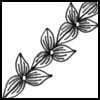 It’s almost Fall, can you feel it in the air? Our South Florida temperatures have dipped from the 90’s all the way into the 80’s 😉
It’s almost Fall, can you feel it in the air? Our South Florida temperatures have dipped from the 90’s all the way into the 80’s 😉
Spiced pumpkin lattes for all …
Belgian CZT Ria Matheussen shares here Samu tangle with us today.
I have found inspiration in the beautiful art of the Dutch artist Maurits Cornelis Escher I have seen already a lot of his influence in many tiles of our lovely Zentangle art and I have several books of his work. The name of his teacher was Samuel Jesserun de Mesquita and that is why I chose the name Samu for this pattern.
In this picture, you see an original work of Escher:
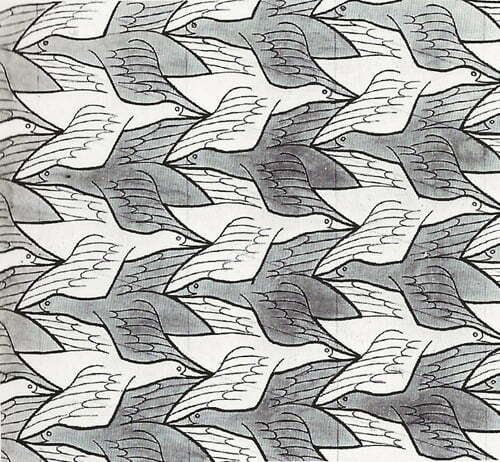
I’d venture to guess there are very few of us who haven’t heard of “M. C. Escher”. As Wikipedia tells us,
Maurits Cornelis Escher (17 June 1898 – 27 March 1972) was a Dutch graphic artist who made mathematically inspired woodcuts, lithographs, and mezzotints. Despite wide popular interest, Escher was for long somewhat neglected in the art world, even in his native Netherlands. He was 70 before a retrospective exhibition was held. In the twenty-first century, he became more widely appreciated, with exhibitions across the world.
His work features mathematical objects and operations including impossible objects, explorations of infinity, reflection, symmetry, perspective, truncated and stellated polyhedra, hyperbolic geometry, and tessellations.
Although Escher believed he had no mathematical ability, he interacted with the mathematicians George Pólya, Roger Penrose, Harold Coxeter and crystallographer Friedrich Haag, and conducted his own research into tessellation.
Early in his career, he drew inspiration from nature, making studies of insects, landscapes, and plants such as lichens, all of which he used as details in his artworks.
He traveled in Italy and Spain, sketching buildings, townscapes, architecture and the tilings of the Alhambra and the Mezquita of Cordoba, and became steadily more interested in their mathematical structure.
There are a lot of avenues for study down that rich rabbit hole but I’ll leave that to you for now, let’s get back to our tangle …
Ria explains more about her Samu tangle,
Samu is not based on the work pictured above because “his birds” are flying in different directions and Samu is always drawn in the same direction but I started to draw a more stylized form after seeing this pic.
Samu is not difficult but you have to pay attention while drawing.
The first step is very important because you are starting with a shape that is rounded only on one side. It is necessary to go further in a good way. I draw a horizontal line which makes it is easier to draw the “leaves” nicely and equally.
I have chosen to fill them in different ways, always starting from the middle of each leaf. You can see that very clear in step four.
There are many other options, as you can see on my Zendala where I used different colors.
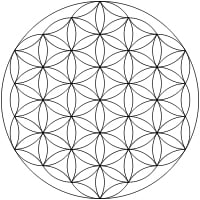 When you create Samu as a background tangle as in Ria’s Steps 5 and 6 instead of a ribbon-style one, you’ll notice you end up with a Flower of Life base composed of leaf shapes.
When you create Samu as a background tangle as in Ria’s Steps 5 and 6 instead of a ribbon-style one, you’ll notice you end up with a Flower of Life base composed of leaf shapes.
Ria illustrates the step-by-step instructions for drawing Samu below. She includes ways to vary filling the “leaf” shape and she features Samu in a beautiful ZIA Zendala. “I worked the whole afternoon on this Zendala and besides Samu you can see that I have also found inspiration in the last Project Packs by using a lot of aura’s, stretched Printemps and those lovely embellishments! ”
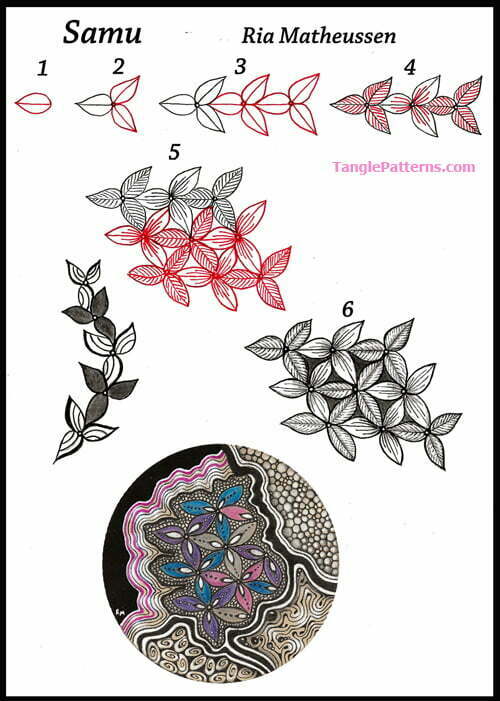
Image copyright the artist and used with permission, ALL RIGHTS RESERVED. These images are for your personal offline reference only. Please feel free to refer to the images to recreate this tangle in your personal Zentangles and ZIAs. However the artist and TanglePatterns.com reserve all rights to the images and they must not be publicly pinned, altered, reproduced or republished. Thank you for respecting these rights. For more information, click on the image for a discussion entitled “Artists for Respect” by several prominent artists. “Integrity is doing the right thing, even when no one is watching.” ~ C.S. Lewis
As you enjoy any of the tangles on the site, please leave a comment of thanks and encouragement to show the artists you appreciate them for sharing their creativity to inspire yours. Your thanks helps motivate them to continue to share! And please share a link to your favorite tangles on social media. Thanks!
Check out the tag riam for more of Ria’s tangles on TanglePatterns.com.
Shana Tova to all our Jewish friends!
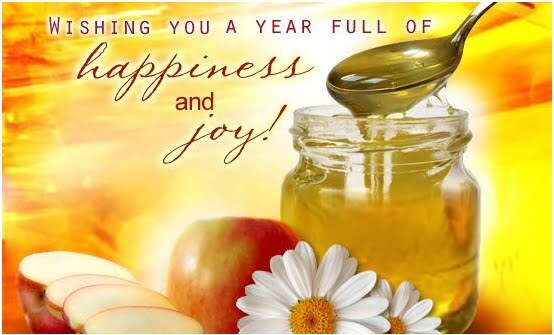
Related Links
- Looking for tangles by Artist or Type? For details visit the ABOUT > HOW TO FIND TANGLES BY ARTIST OR TYPE page on the top menu bar of any page on the site.
- What is a Zentangle? — if you are new to the Zentangle Method, start here for the fundamentals.
- Zentangle terminology — a glossary of terms used in this art form.
- How to use the site — an excellent free video tutorial showing how to use the site as well as pointing out lots of useful features you might have missed.
- Linda's List of Zentangle-Original Patterns — here is the complete list of original tangles (aka "official tangles") created and introduced by founders Rick Roberts and Maria Thomas, including those not published online. If you are new to the Zentangle Method I highly recommend learning a few of the published Zentangle classics first.
- "A Zentangle has no up or down and is not a picture of something, so you have no worries about whether you can draw a hand, or a duck. You always succeed in creating a Zentangle." Patterns that are drawings of a recognizable naturalistic or actual object, figure, or scene, are not tangles. A pattern is not always a tangle — here's what makes a tangle. TIP: tangles never start with pencil planning.
- Un motif n’est pas toujours un tangle — Qu’est-ce qu’un tangle ?
- Un diseño no es siempre un tangle — ¿Qué es un tangle?
- How to submit your pattern deconstruction to TanglePatterns
- For lots of great FREE tutorials on TanglePatterns, click on the TUTORIALS link in the pink alphabetic menu bar below the tangle images at the top of any page.
- Strings! Have we got STRINGS! Click on the STRINGS link in the pink alphabetic menu bar below the tangle images at the top of any page for 250 different (free) Zentangle-starters. More than enough for any lifetime!
- Never miss a tangle! FREE eMAIL NEWSLETTER - visit the Here's how to SUBSCRIBE button (top of left sidebar on any page) and sign up to get notices delivered free to your inbox.
- If you have questions about the TanglePatterns.com TANGLE GUIDE, visit the BOOK REVIEWS tab on the top menu bar of any page on the site for COMPLETE details!
|
.oOo. |
|
Enhance your Zentangle experience while supporting TanglePatterns: |
|
CURRENT EDITION! TanglePatterns.com TANGLE GUIDE, 2025 Edition |
|
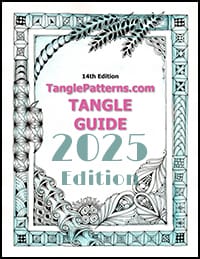 |
The 14th Edition of the TanglePatterns.com TANGLE GUIDE is an instant-download 117-page interactive digital eBook/PDF containing over 2,000 tangles on the site from May 2010 through December 31, 2024. It's a great resource and a must-have digital tool for using the site. Visit the STORE > E-BOOKS page and help keep TanglePatterns.com going by getting your copy now! |
|
"Linda, Thank you! I was relying on too few and getting stuck after 3 years of daily working with Zentangle. This has inspired me to ‘begin again’ with renewed excitement." ~ Barbara R. |
|
| See the BOOK REVIEWS page for more details on its features and view a sample page. Note: this is a digital product you download immediately when you place your order, nothing will be physically mailed to you. | |
| If you're new to Zentangle® and tangling, my TanglePatterns.com BEGINNER'S GUIDE TO ZENTANGLE is just what you need to get started. Also available en Français and en Español. | |
|
|
|
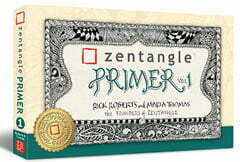 |
This is the only Zentangle book you'll ever need: the fabulous Zentangle PRIMER Vol 1. It's your CZT-in-a-book by the founders of Zentangle®. Visit the STORE tab on the top menu bar or click on the image. For more about the content and to read the rave reviews, visit the BOOK REVIEWS tab. |
| Now available in KINDLE format for $9.99. Spanish Edition here. Japanese Edition here. | |
| "Absolutely the best Zentangle Book yet! As an accomplished artist I used to think I did not need instruction on this art form. How wrong I was! My tangling improved by leaps and bounds after reading this book. If you think you have Zentangle down then you need this book more than ever!" ~ Kris H | |
|
|
|
|
.oOo. |
|

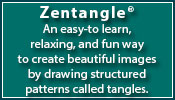




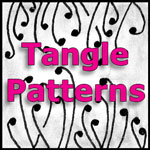
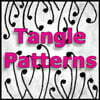
Thank you for honoring a forgotten artist and a sad victim of the Nazi concentration camps. It was interesting to read about de Mosquita. Also, Escher has been one of my favorite artists since a small child. I’m amazed at ‘how did he see that?’
Samu will make a grand background and filler tangle. It went right into my log book. 🙂
I’m very glad with your kind words and I agree, Escher left us a wonderful legacy. Thank you very much for your comment.
lovely! Thank you! I’m trying to get into zentangle after a long absence to combat anxiety. Even art gives me anxiety! Lol! So, I thought, “Whatever the pattern is in today’s email, I’m going to attempt it.” What a delight to open this email and find this one. Simple and beautiful. Absolutely perfect for my first try.
I like your sentence “whatever the pattern is in today’s email, I’m going to attempt it”. That is the right spirit and I’m glad today the new pattern is Samu. So thank you very much for your comment. I wish you succes while exploring Samu. I have drawn it very regular but as a border or ribbon it is not necessary and pleasant to start with!
Nice one Ria
Thank you very much Lianne for this pleasant compliment. There are many ways to create your own Samu (different colors, different ways of filling the “leaves”…) I hope you will enjoy!
What a lovely pattern, Ria. Thanks to you and Linda.
Glad to hear you like Samu. I prefer the ribbon-version because it is easy to draw, you can let the ribbon go in any direction you want and fill it in different ways. You can let the ribbon look like leaves, flowers or even (with a bit of imagination) like flying birds… Thank you for your comment.
Hi Ria, I’m so happy to have woken up to find SAMU as today’s tanglepattern. It’s lovely. I did not know about this artist Escher but I will certainly look into him as his art sounds very interesting. Thank you for the lovely pattern.
Samu is not an exact copy of any pattern of Escher but his work is wonderful and I’m sure it can inspire many people, just as it did to me. The ribbon version is my fave, you can draw it in any direction or it can be used as a frame. You can embellisch or using different colors to become more contrasts… Thank you for your kind feedback!
Thank you so much for sharing Samu and your process. It’s very interesting. I’m a fan of Escher art and concepts too. Beautiful tangle.
Thank you very much for your comment. I wish you succes while exploring Samu. It is pleasant to know you like my tangle!
Thank you Linda for publishing Samu and for telling us a bit more about the work of Escher. Many people have already found inspiration in his legacy and thanks to the links more tanglers ‘ll have the opportunity to know him and his work better. I wish everyone fun while tangling and send you kind regards from Belgium!
This is a beautiful tangle. Thank you so much for sharing with us.
I’m glad you like Samu, there are so many ways to bring variation in this one and I wish you pleasant moments while drawing, thank you for your comment Deborah.
I’m glad you like Samu, there are so many ways to bring variation in this one and I wish you pleasant moments while drawing, thank you for your comment Deborah.